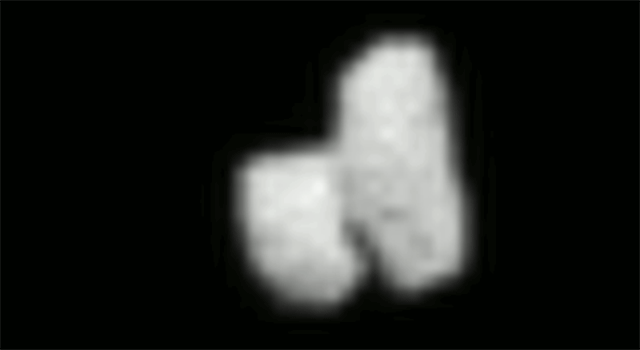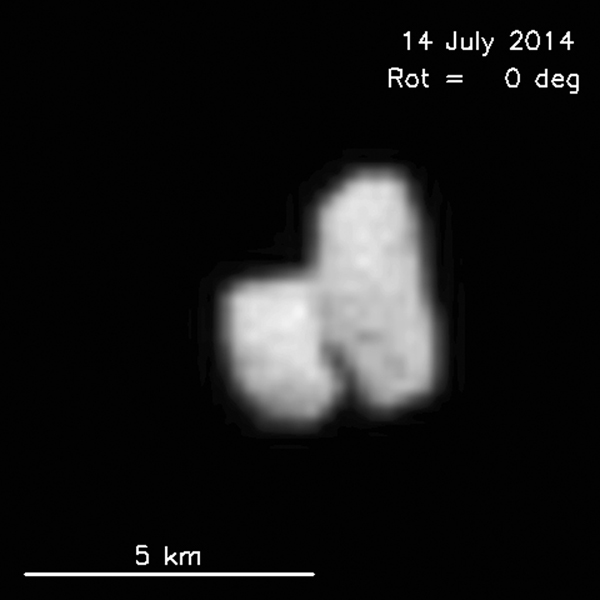As the European Space Agency's spacecraft Rosetta is slowly approaching its destination, comet 67P/Churyumov-Gerasimenko, the comet is again proving to be full of surprises. New images obtained by OSIRIS, the onboard scientific imaging system, confirm the body's peculiar shape hinted at in earlier pictures. Comet 67P is obviously different from other comets visited so far.
“The distance still separating Rosetta from 67P is now far from astronomical,” said OSIRIS Principal Investigator Holger Sierks from the Max Planck Institute for Solar System Research (MPS) in Germany. “It's a trip of less than 14,000 kilometers [about 8,700 miles]. That's comparable to traveling from Germany to Hawaii on a summer holiday.”

The OSIRIS instrument on the European Space Agency's Rosetta spacecraft photographed the mission's destination comet on July 14, 2014, from about 7,500 miles away. The images show that comet 67P/Churyumov-Gerasimenko has a two-part shape. The version at right is enhanced with interpolated data. Credit: ESA/Rosetta/MPS/UPD/LAM/IAA/SSO/INTA/UPM/DASP/IDA
However, while taking a snapshot of Mauna Kea, Hawaii's highest mountain, from Germany is an impossible feat, Rosetta's camera OSIRIS is doing a great job at catching ever clearer glimpses of its similarly sized destination. Images obtained on July 14 clearly show a tantalizing shape. The comet's nucleus consists of two distinctly separated parts.
“This is unlike any other comet we have ever seen before,” said OSIRIS project manager Carsten Güttler from the MPS. “The images faintly remind me of a rubber ducky with a body and a head.” How 67P received this intriguing shape is still unclear. “At this point we know too little about 67P to allow for more than an educated guess,” said Sierks. In the next months, the scientists hope to determine more of the comet's physical and mineralogical properties. These could help them determine whether the comet's body and head were formerly two individual bodies.

In order to get an idea of what seems to be a very unique body, the observed image data can be interpolated to create a smoother shape. “There is, of course, still uncertainty in these processed, filtered images, and the surface will not be as smooth as it now appears,” Güttler pointed out. “But they help us get a first idea.”
Rosetta is an ESA mission with contributions from its member states and NASA. Rosetta's Philae lander is provided by a consortium led by the German Aerospace Center, Cologne; Max Planck Institute for Solar System Research, Gottingen; French National Space Agency, Paris; and the Italian Space Agency, Rome. NASA's Jet Propulsion Laboratory, Pasadena, California, a division of the California Institute of Technology, Pasadena, manages the U.S. participation in the Rosetta mission for NASA's Science Mission Directorate in Washington. Rosetta carries three NASA instruments in its 21-instrument payload.
For more information on the U.S. instruments aboard Rosetta, visit: http://rosetta.jpl.nasa.gov More information about Rosetta is available at: http://www.esa.int/rosetta
Advertisement
Learn more about Nasa





